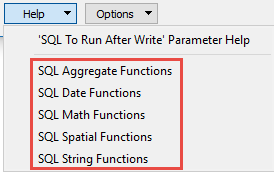Database Connections
|
Database formats include a Database Connection parameter that defines and stores authentication information. For general information about sharing database connections, please see Using Database Connections. Note that Database Connection parameters may differ slightly, depending on context and/or database format. |
Select an existing connection, or Add Database Connection to define a new connection.
The new connection can be made visible only to the current user, or can be shared among multiple users.
Database Connection
The name of the database to connect to.
This format does not yet support creating a database with a password. Use the Windows-only Microsoft Access format instead, or ensure that this parameter field is clear.
The version of the database to create.
- If this option is unchecked (default) and a database already exists, then tables and features are written to the existing database.
- If this option is checked, any existing database is deleted before writing begins.
If no database exists when writing begins, a new database is created.
Note: After a database is deleted, it cannot be recovered – all data is lost.
This parameter is available only when Overwrite Existing Database is enabled.
A template file implies that the database will be overwritten (replaced) before any table handling operations are performed.
If a template file is specified, the writer will make a copy of the template file in the location specified in the Database Path parameter. All operations will be performed on the copy while the template file remains unchanged.
Advanced
The number of features that FME places in each transaction before a transaction is committed to the database.
The default value is 1000.
This parameter allows for the execution of SQL statements before opening a table for writing. For example, it may be necessary to drop a constraint before attempting to write to it. The statements will be executed only when the first feature arrives at the writer.
For detailed information about SQL functions, click the corresponding menu item in the .
Available menu options depend on the format.
Multiple SQL commands can be delimited by a character specified using the FME_SQL_DELIMITER directive, embedded at the beginning of the SQL block. The single character following this directive will be used to split the SQL block into SQL statements, which will then be sent to the database for execution. Note: Include a space before the character.
For example:
FME_SQL_DELIMITER ; DELETE FROM instructors ; DELETE FROM people WHERE LastName='Doe' AND FirstName='John'
Multiple delimiters are not allowed and the delimiter character will be stripped before being sent to the database.
Any errors occurring during the execution of these SQL statements will normally terminate the reader or writer (depending on where the SQL statement is executed) with an error. If the specified statement is preceded by a hyphen (“-”), such errors are ignored.
This parameter allows for the execution of SQL statements after a set of tables has been written. For example, it may be necessary to clean up a temporary view after creating it.
For detailed information about SQL functions, click the corresponding menu item in the .
Available menu options depend on the format.
Multiple SQL commands can be delimited by a character specified using the FME_SQL_DELIMITER directive, embedded at the beginning of the SQL block. The single character following this directive will be used to split the SQL block into SQL statements, which will then be sent to the database for execution. Note: Include a space before the character.
For example:
FME_SQL_DELIMITER ; DELETE FROM instructors ; DELETE FROM people WHERE LastName='Doe' AND FirstName='John'
Multiple delimiters are not allowed and the delimiter character will be stripped before being sent to the database.
Any errors occurring during the execution of these SQL statements will normally terminate the reader or writer (depending on where the SQL statement is executed) with an error. If the specified statement is preceded by a hyphen (“-”), such errors are ignored.
